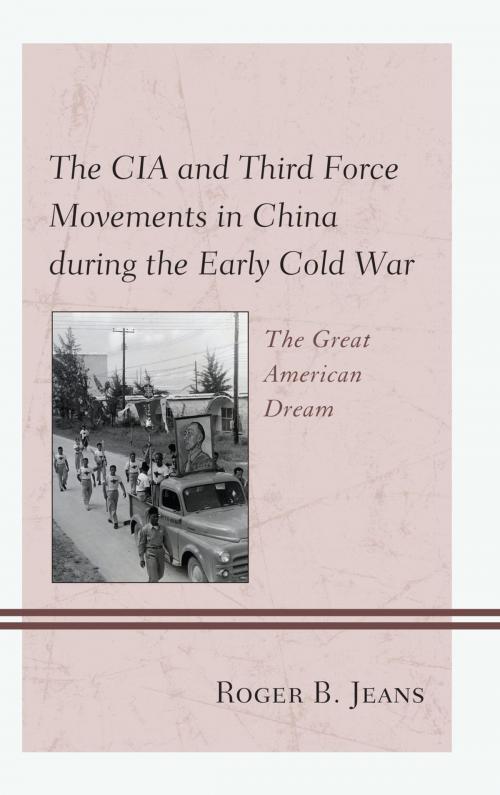The CIA and Third Force Movements in China during the Early Cold War
The Great American Dream
Nonfiction, History, Asian, Southeast Asia, Social & Cultural Studies, Political Science, International| Author: | Roger B. Jeans | ISBN: | 9781498570060 |
| Publisher: | Lexington Books | Publication: | November 27, 2017 |
| Imprint: | Lexington Books | Language: | English |
| Author: | Roger B. Jeans |
| ISBN: | 9781498570060 |
| Publisher: | Lexington Books |
| Publication: | November 27, 2017 |
| Imprint: | Lexington Books |
| Language: | English |
When the Chinese Communists defeated the Chinese Nationalists and occupied the mainland in 1949–1950, U.S. policymakers were confronted with a dilemma. Disgusted by the corruption and, more importantly, failure of Chiang Kai-shek’s Nationalist armies and party and repelled by the Communists’ revolutionary actions and violent class warfare, in the early 1950s the U.S. government placed its hopes in a Chinese “third force.” While the U.S. State Department reported on third forces, the CIA launched a two-prong effort to actively support these groups with money, advisors, and arms.
In Japan, Okinawa, and Saipan, the agency trained third force troops at CIA bases. The Chinese commander of these soldiers was former high-ranking Nationalist General Cai Wenzhi. He and his colleagues organized a political group, the Free China Movement. His troops received parachute training as well as other types of combat and intelligence instruction at agency bases. Subsequently, several missions were dispatched to Manchuria—the Korean War was raging then—and South China. All were failures and the Chinese third force agents were killed or imprisoned. With the end of the Korean War, the Americans terminated this armed third force movement, with the Nationalists on Taiwan taking in some of its soldiers while others moved to Hong Kong. The Americans flew Cai to Washington, where he took a job with the Department of Defense.
The second prong of the CIA’s effort was in Hong Kong. The agency financially supported and advised the creation of a third force organization called the Fighting League for Chinese Freedom and Democracy. It also funded several third force periodicals. Created in 1951 and 1952, in 1953 and 1954 the CIA ended its financial support. As a consequence of this as well as factionalism within the group, in 1954 the League collapsed and its leaders scattered to the four winds. At the end, even the term “third force” was discredited and replaced by “new force.”
Finally, in the early 1950s, the CIA backed as a third force candidate a Vietnamese general. With his assassination in May 1955, however, that effort also came to naught.
When the Chinese Communists defeated the Chinese Nationalists and occupied the mainland in 1949–1950, U.S. policymakers were confronted with a dilemma. Disgusted by the corruption and, more importantly, failure of Chiang Kai-shek’s Nationalist armies and party and repelled by the Communists’ revolutionary actions and violent class warfare, in the early 1950s the U.S. government placed its hopes in a Chinese “third force.” While the U.S. State Department reported on third forces, the CIA launched a two-prong effort to actively support these groups with money, advisors, and arms.
In Japan, Okinawa, and Saipan, the agency trained third force troops at CIA bases. The Chinese commander of these soldiers was former high-ranking Nationalist General Cai Wenzhi. He and his colleagues organized a political group, the Free China Movement. His troops received parachute training as well as other types of combat and intelligence instruction at agency bases. Subsequently, several missions were dispatched to Manchuria—the Korean War was raging then—and South China. All were failures and the Chinese third force agents were killed or imprisoned. With the end of the Korean War, the Americans terminated this armed third force movement, with the Nationalists on Taiwan taking in some of its soldiers while others moved to Hong Kong. The Americans flew Cai to Washington, where he took a job with the Department of Defense.
The second prong of the CIA’s effort was in Hong Kong. The agency financially supported and advised the creation of a third force organization called the Fighting League for Chinese Freedom and Democracy. It also funded several third force periodicals. Created in 1951 and 1952, in 1953 and 1954 the CIA ended its financial support. As a consequence of this as well as factionalism within the group, in 1954 the League collapsed and its leaders scattered to the four winds. At the end, even the term “third force” was discredited and replaced by “new force.”
Finally, in the early 1950s, the CIA backed as a third force candidate a Vietnamese general. With his assassination in May 1955, however, that effort also came to naught.















